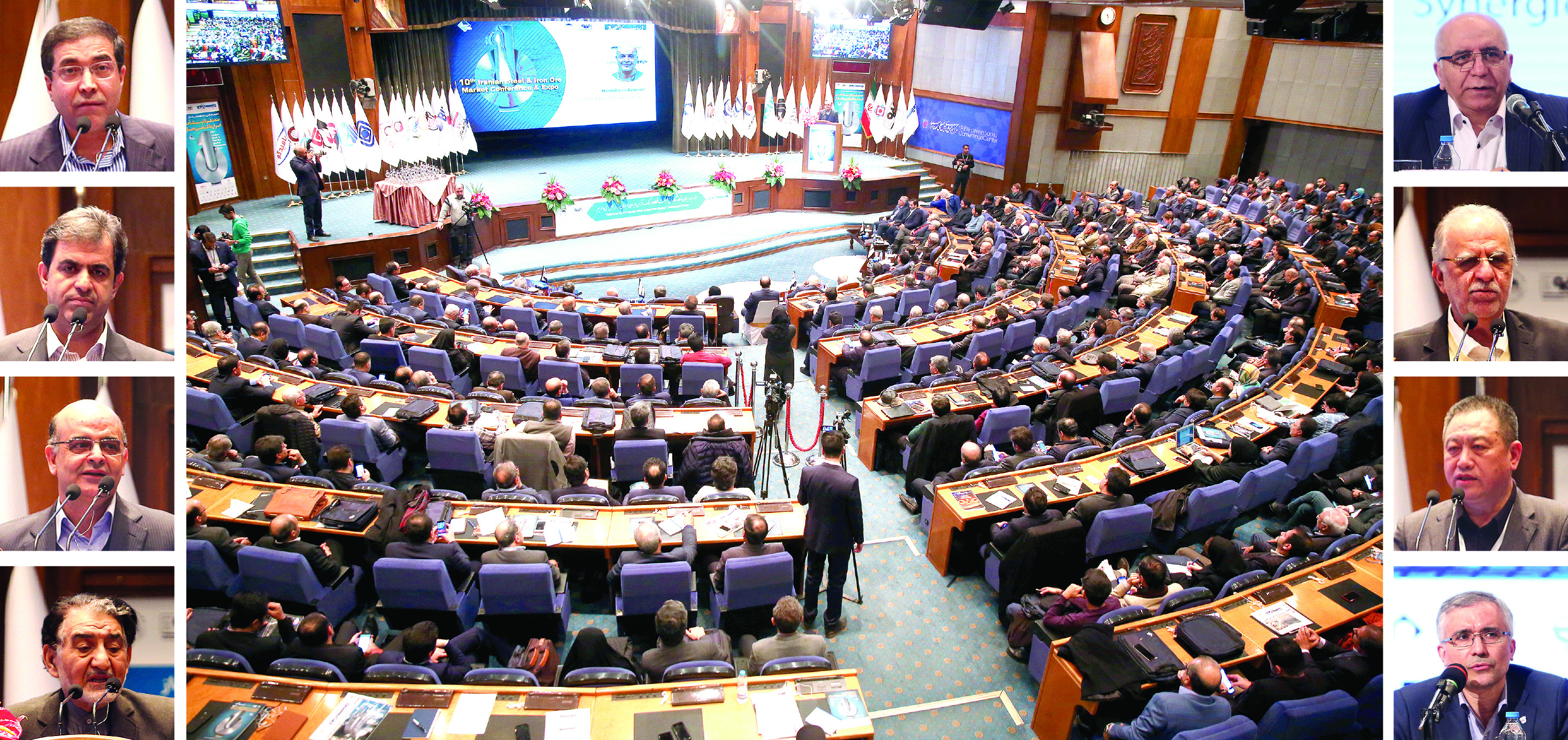The 10th edition of Iranian Steel & Iron Ore Market Conference & Expo, also known as “ISMC 2020”, opened in Tehran on Tuesday, in the presence of top officials and experts related to the domestic steel industry.
Hosted by Donya-e-Eqtesad Media Group, the parent company of Financial Tribune, the event is held annually to take stock of developments in Iran's steel industry and to survey challenges and opportunities facing the strategic sector.
More than 60 domestic and international firms are participating in the two-day ISMC 2020.
The conference opened with the speech of Alireza Bakhtiari, the head of Donya-e-Eqtesad Media Group, who reviewed Iranian steel industry's roadmap against the backdrop of US sanctions.
"The 10th Iranian Steel & Iron Ore Market Conference is being held at a time when the most unprecedented sanctions have been imposed on the Iranian economy," he said, adding that policymakers ought to ensure their decisions are based on neutralizing the effects of sanctions.
Referring to the controversial tariffs recently imposed on the export of unprocessed minerals, Bakhtiari said, “Although the decision is aimed at encouraging mineral producers to create products with more value added, iron ore producers believe that under the current market conditions, even the export of unprocessed minerals is vital to keep the economy going as it helps bring in the much-needed foreign currency revenues.”
The Ministry of Industries, Mining and Trade started imposing 20-25% tariffs on unprocessed mineral export as of Sept. 23.
Export Tariffs
Iron ore seems to be at the forefront of the new restrictive measure, as experts warn Iran will face a shortage of iron ore to feed its steel industries in the near future.
The tariff on exports of iron ore concentrates and pellets stands at 25%.
Data released by the Iranian Mines and Mining Industries Development and Renovation Organization show iron ore exports witnessed a considerable downturn as of the seventh Iranian month (Sept. 23-Oct. 22, 2019), at the beginning of which the Industries Ministry started to impose the punishing tariffs.
Iron ore exports during the eighth month (Oct. 23-Nov. 21) saw staggering declines of 75.43% month-on-month and 80.32% year-on-year to reach only 311,000 tons.
In fact, iron ore exports during this month hit the lowest point since the beginning of the last Iranian year (March 21, 2018).
The country exported 1.26 million tons of iron ore during the seventh month to register an increase of 8.48% compared to the month before and a 32.44% decline compared with last year’s similar month.
"Iran’s plan to produce 55 million tons of steel by the fiscal 2025-26 requires 160 million tons of iron ore. Some experts believe a shortage of at least 30 million tons of iron ores is one of the most basic hurdles preventing this goal," Bakhtiari said.
He noted that as per Iran's Steel Comprehensive Plan, of the total production of 55 million tons, about 35 million tons are to be consumed domestically and the remaining 20 million tons need to be exported.
"The latest analysis, considering current conditions, shows domestic consumption will be between 25 and 27.5 million tons by the fiscal 2025-26. If the 55-million-ton goal is achieved, there will be around 27.5 million tons of surplus, which need to be exported," he said.
The Iranian Mines and Mining Industries Development and Renovation Organization's latest report on the completion of under-construction steel production units shows a total of 19.1 million tons will be added to Iran’s annual steel production capacity by the fiscal 2023-24.
Iran's current steel production capacity stands at 35 million tons per year, Deputy Minister of Industries, Mining and Trade Jafar Sarqeini said recently.
The addition of 19.1 million tons by the time the under-construction projects come on stream to the current capacity means the aggregate output capacity will reach 54.1 million tons by March 2024—only 900,000 tons short of the target, for which Iranian steelmakers will have one further year.
Mohammad Abka, the head of Foolad Technic International Engineering Company, also confirmed that the Iranian steel industry is on track to reach its projected targets.
According to Abka, Iran's crude steel production capacity, actual production and exports stood at 33.9 million tons, 24.7 million tons and 5.5 million tons respectively in the last fiscal year (March 2018-19).
He expects the figures to reach 37.9, 26.3 and 6.5 million tons by the end of the current Iranian year (March 19, 2020).
"If the current trend continues, Iran will definitely reach its 55-million-ton target by the end of the fiscal 2025-26," he said.
World's 10th Biggest Steelmaker
The latest report released by the World Steel Association shows Iranian steel mills produced 23.64 million tons of crude steel during the 11 months of 2019 (January to November), which indicates a 5.3% rise compared with the corresponding period of 2018.
Iran’s ranking remained unchanged compared to Worldsteel's previous monthly report: the world’s 10th biggest crude steel producer.
The country is placed between Brazil (ninth) with 29.82 million tons of production and Italy (11th) with 21.81 million tons, the new report shows.
The world’s 64 steelmakers produced a total of 1.68 billion tons of steel over the 11 months, up 2.7% YOY.
China was the world’s largest crude steel producer with 904.17 million tons of steel output, up 7% YOY.
Crude steel is defined as steel in its first solid (or usable) form: ingots, semi-finished products (billets, blooms and slabs). This is not to be confused with liquid steel, which is steel poured.
Mideast's Largest Area Under Exploration
Considering the mineral explorations underway, there is no concern about the supply of iron ores needed by domestic steel mills, said Bahram Shakouri, the head of Mines and Mineral Industries Commission affiliated to Iran Chamber of Commerce, Industries, Mines and Agriculture, in an address to the conference.
"If proper management of steel chain is applied, the 55-million-ton goal will be fulfilled. What's more we will be facing no problems in supplying raw materials to domestic steel producers for 33 years after the deadline [March 2025-26]," he said.
According to Deputy Industries Minister Khodadad Gharibpour, Iran has the largest area under mineral exploration in the Middle East.
IMIDRO, the biggest state-owned holding in Iran’s mining sector, plans to cover 300,000 square kilometers of the country's explorable land for mineral explorations by the end of the current fiscal year (March 19, 2020).
The organization carried out exploration over 270,000 square kilometers during President Hassan Rouhani's first term in office (August 2013-17).
According to Gharibpour, who is also the chairman of IMIDRO, 65% of Iran’s total explorable mineral areas (1 million kilometers) belong to the organization.
He noted that IMIDRO will have invested $3.9 billion in Iran's mining sector by the end of the current year, adding that 10,000 direct jobs as well as many more indirect jobs will be created as a result; this is while $2.1 billion worth of projects were implemented by IMIDRO in the last Iranian year (March 2018-19).
Ali Asqarzadeh, IMIDRO’s director for exploration, says the highest volume of explorations in Iran pertains to copper, iron ore and coal.
According to Gharibpour, half of Iran’s 600,000-square kilometers of exploratory area has been examined for mineral reserves.
In his words, most mining explorations in Iran have been carried out at shallow depths, while excavating deeper would lead to a twofold increase in mineral reserves.
MSC Development Plans
Hamid Reza Azimian, the managing director of Mobarakeh Steel Company, was the next speaker at the conference. He expounded on the giant steel mill's development projects.
"Mobarakeh Steel Company is currently developing several projects, the most important of which include the establishment of the mill's hot rolled mill No. 2, completing the 1-million-ton steel production line of Sefid Dasht Steel Company, completing the 5-million-ton production line of Sangan Steel Company, increasing the steel production capacity of Hormozgan Steel Company from 1.5 million tons to 2 million tons, and completing Ardakan Steel’s graphite electrode plan," he said.
The latest IMIDRO report shows that with 13.26 million tons of output, MSC had the largest share of steel production in Iran during the first nine months of the current Iranian year (March 21-Dec. 21, 2019).
The company produced 6.19 million tons of finished steel during the period, posting a 2% rise compared with last year's corresponding period.
In addition, 7.06 million tons of semi-finished products were produced by MSC–unchanged year-on-year.
Need to Focus on Exports Amid Sanctions
Gharibpour, the IMIDRO chief, was the next and last speaker in line. He stressed the need to focus on exports in the face of US sanctions.
"US sanctions have targeted Iran’s steel exports because of their profitability. The enemy has targeted our strength; thus, all of our policies must be in line with facilitating exports … We need to move towards production of high value-added steel products," he concluded.
Fresh US sanctions against Iranian steel exports are likely to have little impact because pricing remains attractive to buyers in Asia, Iran-based sources told S&P Global Platts.
“The recent US sanctions are not expected to have a big impact on Iranian steel producers, as long as steel products continue to have attractive prices,” a trader said.
“Even during the previous sanctions, Asian buyers were not put off from purchasing from Iran so I don’t think these new sanctions will have an effect, particularly now that the rial has depreciated.”
Secondary sanctions were introduced last year on some metals and mine products.
The trader said domestic mills can be very competitive, although some costs have increased such as freight, adding that inflation, which is already high, can be a problem for domestic steel demand.
Iran’s steel exports have increased during the period of secondary sanctions against the country, according to IMIDRO.
A large volume of Iranian steel is traded overseas via traders in locations, such as Dubai in the UAE.
Market sources said China can be expected to continue to import some Iranian steel, mainly via Chinese companies active in the Middle East. Chinese buyers have been taking an increasing tonnage of Iranian billets, slab and pig iron since June when China banned scrap metal imports and domestic prices soared as a result.
Chinese customs data show it imported at least 400,000 tons of Iranian billets and slabs over January-November.
Amid tensions between the US and Iran before the latest sanctions were announced earlier this month, the Indonesian government had already asked local buyers to avoid Iranian billet. One major Indonesian importer alone had been buying around 200,000 tons/year of Iranian billet. Other recent buyers of Iranian steel include Thailand, Oman and Iraq.
Turkey also buys from Iran, although as one of the largest producers of rebars, it gets most of its supply domestically. It imported 141,300 tons of rebar from Iran in the first 11 months of the year, up sharply from 30,700 tons in the same period of 2018, according to the most recent data from the Turkish Statistical Institute, as cheaper Iranian rebar offers to Turkey spurred buying interest, especially in the east of the country. In the whole of 2018, Turkey imported just 50,320 tons of rebar from Iran.
Iran’s main steel producers, excluding small private sector mills, exported 5.2 million tons of finished and semi-finished steel in the first nine months of the current Iranian year (ending Dec. 21), up 19% YOY. However, in the past month alone, exports totaled 485,000 tons, a 91% YOY increase, according to data from IMIDRO.



